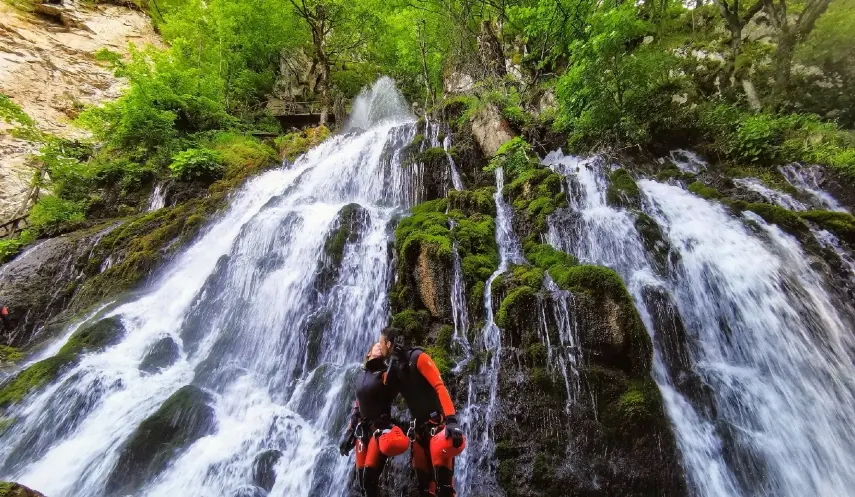PERUĆICA - EUROPEAN RAINFOREST RARITY AND TOURIST ATTRACTION
Republika Srpska - Foča - tourist destinations /4/
07/22/2025
10:31

FOČA, JULY 22 /SRNA/ - Perućica Rainforest in Sutjeska National Park near Foča, as a European rarity and one of the best-preserved parts of nature in Europe, is a great challenge for scientific researchers, and increasingly for tourists and adventurers from all over the world.
Located in the gap between the highest mountain peaks of BiH - Maglić, Sniježnica and Volujak - Perućica is in many ways a phenomenon and a natural monument that has invaluable biological and landscape value.
Back in 1938, in the time of the Kingdom of Yugoslavia, foresters, while preparing a survey on Mount Maglić, found beautiful specimens of beech, fir, and spruce in the Perućica river basin, whose wood mass was more than 1,000 cubic meters per hectare, and the height of the trees reached more than 60 meters.
For the purposes of scientific research and teaching, this area was separated from regular forest management in 1952, and two years later it was enlarged to 1,434 hectares and placed under protection as a nature reserve, and in 1962 the Sutjeska National Park was established, which included the Perućica Rainforest.
WATERFALL SKAKAVAC FALLS DOWN FROM 75 METERS IN HEART OF RAINFOREST
Compared to other European rainforests, its relief makes it specific - it is a trough-shaped depression of the Perućički stream, with the hydrogeological phenomenon of the Skakavac /Locust/ waterfall, which falls into the heart of the rainforest from a height of 75 meters, and it is especially interesting as a habitat for extremely rare plant species that survived the ice age.
Mountain birch, Sutjeska bellflower, fragrant glandular tree, and Pančić's lettuce are some of the endemic, rare and endangered species that are preserved and very prominent in the Sutjeska National Park.
These plant species, which were previously exposed to glaciers, descended to these low Balkan latitudes, and later, when thaws occurred, the glaciers retreated and these species were left behind in these canyon valleys.
Starting from the beginning of Perućica, more precisely from the confluence of the Perućica stream in Sutjeska at 600 meters above sea level, to Prijevor, the flat plain at the very top of Maglić at 1,700 meters, various forest belts line up - from the first gallery forests, through oak and hornbeam forests, European beech, then the combination of beech and fir, independent fir and spruce conifers to the pine zone that ends the vegetation zone.
In Perućica, everything is left to nature, every birth, development, and death of trees takes place without any human influence, and it is believed that most of this rainforest has never been visited by a human foot.
"THREE SISTERS" - SPRUCE TREES OVER 250 YEARS OLD
In the 1970s, the Faculty of Forestry in Sarajevo took cuttings from three huge spruce trees, known as the "three sisters," which at the time were more than 62 meters tall.
They were two and a half meters wide in diameter and were estimated to be more than 250 years old. Of the "three sisters," two are alive today, and one is on the ground.
A special gem of Perućica is the Skakavac waterfall, an extremely attractive hydrological phenomenon.
It is a permanent watercourse, unlike some known in Bosnia and Herzegovina and the Balkans, which do not have a constant flow and as such is the highest in these areas. The flow varies, in summer it is about nine liters per second, and in spring and autumn more than 12 liters. It has several sources of supply, mainly from Maglić and Volujak.
MORE AND MORE CHINESE TOURISTS - GUIDED TOURS MANDATORY!
Tourist tours of the rainforest are organized in groups, along a marked trail, with the mandatory accompaniment of a National Park guide.
The starting point is Dragoš Sedlo. It is a beautiful viewpoint, 12 kilometers from Tjentište. The tour of the rainforest takes from three and a half to four hours. There are more and more foreign tourists, mainly from France, Germany, Belgium, Scandinavian countries, recently from the USA and, most interestingly, from China.
The Sutjeska National Park has good cooperation with rafting agencies and clubs from Foča, with whom it exchanges tourists.
PRIJEVOR SUMMER SHELTERS – ATTRACTION
Along with Perućica, the Prijevor plateau is an unavoidable and extremely attractive destination for tourists, which can be reached along the edge of the rainforest.
In Prijevor, which is the starting point for the climb to Maglić, there are the National Park's summer shelters, three stone-built huts with 18 beds, and right next to them are the summer shelters of the Nikolić family from Bileća.
Visitors find it particularly interesting that they can see the authentic way of preparing cheese and sour cream, which they can also try and buy.
Perućica is a natural laboratory and an inexhaustible source for scientific research, both for domestic and foreign researchers.
The Environmental Center from Banja Luka has conducted several studies on the genofond in recent years, while researchers from Germany and Spain have focused on mountain watercourses.
It was research related to climate change, which is also being felt in this area. They also investigated glacial lakes, which are in the process of remodeling.
Perućica is one of the last remaining rainforests in Europe. There are several more in Europe. There is one on the border of Belarus and Poland, but it does not have such a specific relief, it is on a plain, and some authors would say that the habitats of rare species are more valuable here because they are at southern latitudes.
Perućica is also inhabited by a rich fauna. The symbol of the park is the chamois and roe deer, and there is also a large population of bears, wolves, and a large number of migratory birds.
Along with the natural phenomenon of Perućica, the highest peak in BiH - Maglić, and Zelengora with eight glacial lakes, the National Park is also attractive as a tourist attraction as the area where the Battle of Sutjeska took place, a famous epic from World War II that is a symbol of the heroic fight for freedom.
Right on Dragoš Sedlo, from which the tourist tour of the rainforest begins, there is a monument to the Partisan Hospital, on the spot where German SS units killed the wounded Partisans and paramedics.
Tags

SANCTIONS LIFTED FOR OFFICIALS AND LEGAL ENTITIES IN SRPSKA

FIRST HAGUE TRIBUNAL CONVICT DUŠKO TADIĆ PRESENTS BOOK, PLANS TO SEEK REVIEW OF VERDICT

CVIJANOVIĆ: GOOD NEWS ABOUT LIFTING OF SANCTIONS ON SRPSKA OFFICIALS

SANCTIONS AGAINST SRPSKA OFFICIALS LIFTED


